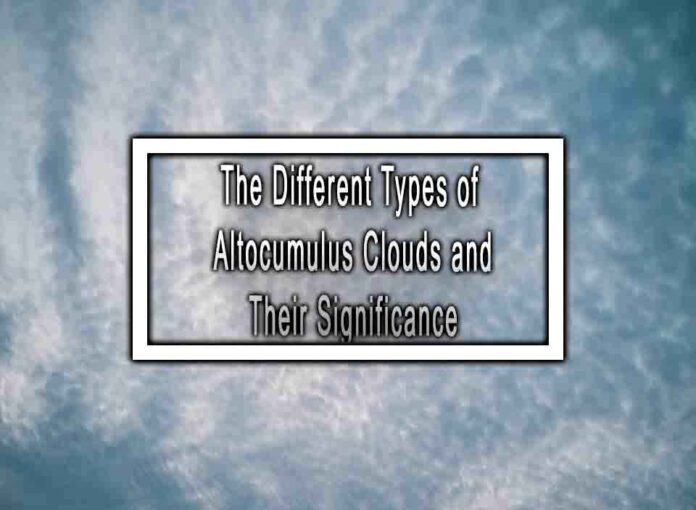Altocumulus clouds are mid-level clouds that form between 6,500 and 20,000 feet (2,000 to 6,000 meters) above sea level. They are typically white or gray and appear as layers or patches of cloud puffs. Altocumulus clouds come in various types, and each type can provide important information about weather patterns. Here are some different types of altocumulus clouds and their significance:
1. Altocumulus Castellanus:
- Altocumulus castellanus clouds have small, tower-like projections on their tops, resembling the turrets of a castle.
- They indicate atmospheric instability and can be a sign of potential thunderstorm development later in the day.

2. Altocumulus Lenticularis:
- Altocumulus lenticularis clouds have a distinctive lens or almond-shaped appearance.
- They often form near mountains and are associated with strong winds and turbulence.
- These clouds are sometimes mistaken for UFO sightings due to their unusual shape.
3. Altocumulus Floccus:
- Altocumulus floccus clouds are characterized by small, tufted cloud elements with ragged, shredded edges.
- They are often seen with other altocumulus clouds and can indicate a weak disturbance in the atmosphere.
4. Altocumulus Stratiformis:
- Altocumulus stratiformis clouds appear as a uniform, gray or white layer with a somewhat flattened appearance.
- They are often associated with stable atmospheric conditions and may not produce precipitation.
5. Altocumulus Duplicatus:
- Altocumulus duplicatus clouds are characterized by multiple cloud layers that appear stacked on top of each other.
- They can indicate the presence of strong wind shear or changing wind patterns at different altitudes.
6. Altocumulus Perlucidus:
- Altocumulus perlucidus clouds form in regular patches or rows with gaps of clear sky between them.
- They are associated with fair weather and are often seen in the morning as the atmosphere stabilizes.
7. Altocumulus Undulatus:
- Altocumulus undulatus clouds have a wavy or undulating appearance.
- They are often seen in the wake of a weather disturbance and can signal changing atmospheric conditions.
8. Altocumulus Radiatus:
- Altocumulus radiatus clouds have cloud elements that appear to converge toward a point on the horizon.
- They are often associated with the presence of high-altitude winds and atmospheric convergence.
9. Altocumulus Pileus:
- Altocumulus pileus clouds are small caps or “helmets” that form on top of cumulus clouds.
- They indicate rapid updrafts and can be a sign of developing thunderstorms.
10. Altocumulus Volutus:
Altocumulus volutus clouds have a roll-like or tubular appearance. – They are often seen in the presence of strong winds or wind shear, particularly in the vicinity of thunderstorms.
Understanding the various types of altocumulus clouds and their characteristics can help meteorologists and weather enthusiasts predict weather changes and assess atmospheric stability. These clouds, when observed in combination with other cloud types, can provide valuable insights into current and upcoming weather patterns.











